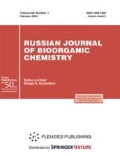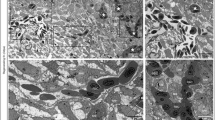Abstract—
Vasculogenic mimicry, the formation of vascular channels lined with tumor cells of a highly malignant phenotype, is currently considered as an additional system of blood supply of the tumor. Experimental studies in vivo have repeatedly demonstrated that vascular channels form in the areas of a tumor with a low density of blood vessels. It is supposed that the formation of a network of these channels inside the tumor maintains homeostasis and prevents early necrosis within it. In this work, bifunctional compounds based on a combination of quinazoline and hydroxamic acid in one molecule were examined for the ability to inhibit the migration of tumor cells and vasculogenic mimicry.


Similar content being viewed by others
REFERENCES
Persy, I.S., Wick, J.Y., and Kaufman, B., Nat. Rev. Clin. Oncol., 2009, vol. 6, pp. 569–577.
Azam, F., Mehta, S., and Harris, A.L., Eur. J. Cancer, 2010, vol. 46, pp. 1323–1332.
Maniotis, A., Folberg, R., Hess, A., Seftor, E.A., Gardner, L.M., Pe’er, J., Trent, J.M., Meltzer, P.S., and Hendrix, M.J., Am. J. Pathol., 1999, vol. 55, pp. 739–752.
Zhang, S., Zhang, D., and Sun, B., Cancer Lett., 2007, vol. 254, pp. 157–164.
Van der Schaft, W., Seftor, R.E., Seftor, E.A., Hess, A.R., Gruman, L.M., Kirschmann, D.A., Yokoyama, Y., Griffoen, A.W., and Hedrix, M.J., J. Natl. Cancer Inst., 2004, vol. 96, no. 19, pp. 1473–1477.
Berube, G., Expert Opin. Drug Discov., 2016, vol. 11, no. 3, pp. 281–305.
Yoon, S. and Eom, G.H., Chonnam Med. J., 2016, vol. 52, no. 1, pp. 1–11.
Giannini, G., Battistuzzi, G., and Vignola, D., Bioorg. Med. Chem. Lett., 2015, vol. 25, no. 3, pp. 459–461.
Rao, M., Valentini, D., Zumla, A., and Maeurer, M., Int. J. Infect. Dis., 2018, vol. 69, pp. 78–84.
Muri, E.M., Nieto, M.J., Sindelar, R.D., and Williamson, J.S., Curr. Med. Chem., 2002, vol. 9, pp. 1631–1653.
Ahmad, S. and Ahmad, I., Med. Chem. Commun., 2017, vol. 8, pp. 871–885.
Asif, M., Int. J. Med. Chem., 2014, article ID 395637.
Folkman, J., Curr. Mol. Med., 2003, vol. 3, pp. 643–651.
Hillen, F. and Griffioen, A.W., Cancer Metastasis Rev., 2007, vol. 26, pp. 489–502.
Vartanian, A., Golubeva, I., and Shprakh, Z., Horizons Cancer Res., 2017, vol. 65, pp. 13–34.
Sashidhara, K.V., Palnati, G.R., Dodda, R.P., Avula, S.R., and Swami, P., Synlett, 2013, vol. 24, pp. 105–113.
Vailhe, B., Vittet, D., and Feige, J., Lab. Invest., 2001, vol. 81, pp. 439–452.
Mikhailova, I.N., Lukashina, M.I., Baryshnikov, A.Yu., et al., Vestn. Ross. Akad. Med. Nauk., 2005, vol. 7, pp. 37–40.
Naito, S., von Eschenbach, A.C., Giavazzi, R., and Fidler, I.J., Cancer Res., 1986, vol. 46, pp. 4109–4115.
Funding
The study was supported by the Ministry of Science and Higher Education of the Russian Federation (Agreement no. 075-11-2018-172 of 03.12.18). The unique identifier of the project is RFMEFI62418X0051.
Author information
Authors and Affiliations
Corresponding author
Ethics declarations
COMPLIANCE WITH ETHICAL STANDARDS
This article does not contain any studies involving animals or human participants performed by any of the authors.
Conflict of Interests
The authors declare that there is no conflict of interest.
Additional information
Translated by S. Sidorova
Abbreviations: HOBt, N-hydroxybenztriazole; NMM, N-methylmorpholine; TBTU, 2-(1H-benzotriazol-1-yl)-1,1,3,3-tetramethylaminium tetrafluoroborate; VEGF, vascular epithelial growth factor; FCS, fetal calf serum; VM, vasculogenic mimicry; CLS, capillary-like structure.
Corresponding author: phone: +7 (916) 412-61-43; e-mail: ovn65@yandex.ru.
Rights and permissions
About this article
Cite this article
Vartanian, A.A., Khochenkov, D.A., Khochenkova, Y.A. et al. Effect of Derivatives of Hydroxamic Acids on Vasculogenic Mimicry. Russ J Bioorg Chem 46, 252–263 (2020). https://doi.org/10.1134/S106816202002017X
Received:
Revised:
Accepted:
Published:
Issue Date:
DOI: https://doi.org/10.1134/S106816202002017X




